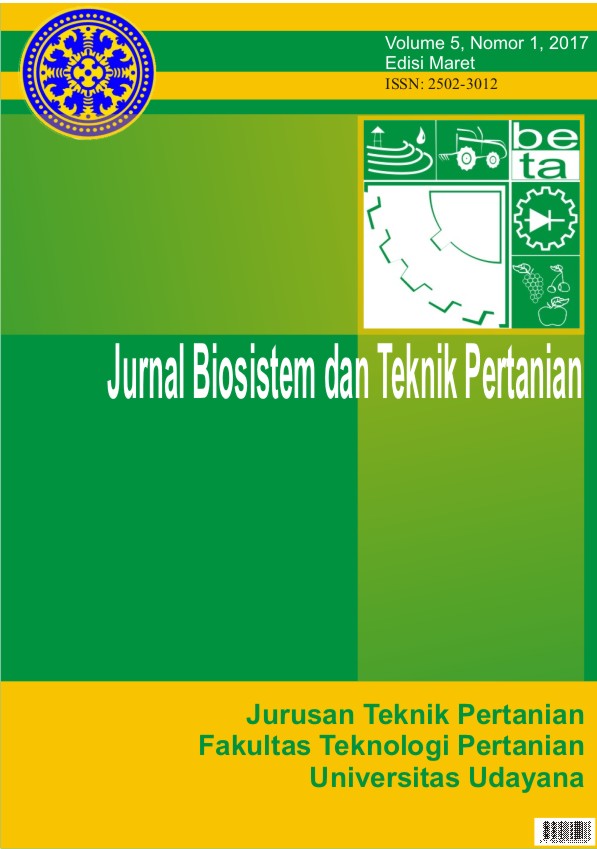Kajian Proses Fermentasi Sludge Kotoran Sapi
Abstract
Penelitian ini bertujuan untuk mengetahui pengaruh perlakuan sirkulasi udara terhadap proses fermentasi sludge kotoran sapi dan juga mengetahui kualitas sludge yang dihasilkan sesuai dengan SNI kompos No. 19-7030-2004. Perlakuan sirkulasi udara dilakukan dengan menggunakan aerator. Ada tiga kombinasi perlakuan yang dicoba, yaitu aerator dan drum bermantel, aerator dan drum tanpa mantel, serta tanpa aerator dan drum tanpa mantel (perlakuan kontrol). Hasil penelitian ini menujukan bahwa setiap perlakuan pada proses fermentasi memiliki fluktuasi suhu yang berbeda antara 21,56-24,41 oC. Suhu ini merupakan syarat untuk pertumbuhan mikroba mesofilik. Kondisi keasaman dari material sludge yang diperoleh pada awal sampai akhir fermentasi seluruh perlakuan telah memenuhi kondisi proses fermentasi yang optimal, yaitu pada kisaran pH 6,92-7,65. Pengaruh sirkulasi udara didalam biodigester dapat mempercepat pemecahan protein menjadi C-organik dan N-total yaitu C-organik = 24,22% dan N-total = 1,80%. Kompos yang dihasilkan dengan proses fermentasi memiliki karakteristik rasio C/N = 13,46 dan memiliki penampakan warna coklat kehitaman. Karakteristik kompos ini sesuai dengan kualitas kompos SNI No. 19-7030-2004, yaitu pH = 6,80-7,49, C-organik = 9,80-32%, N-total = 0,40%, rasio C/N = 10-20.
This research aimed to determine the effect of air circulation treatment toward cow manure sludge fermentation process and to determine the quality of sludge that was produced accordance to Indonesia National Standard (SNI) of Compost No. 19-7030-2004. The air circulation treatment was done by using aerator. There were three combination treatments of air circulation: the aerator and drum with coat, aerator and drum without coat, and without aerator and drum without coat was applied as a control. The results of this study indicate that each treatment in the fermentation process had a different temperature fluctuations between 21.56 to 24.41 °C. Temperature is a requirement for mesophilic microbial growth. The acidity condition of the sludge material that obtained at the beginning until the end of fermentation was the whole treatment has fulfilled the optimal conditions of fermentation process, with range of pH was from 6.92 to 7.65. The influence of air circulation inside the drum without the coat of husk can accelerate the breakdown of proteins into C-organic and N-total, that was C-organic= 24.22%, and N-total = 1.80%. The compost that produced by the fermentation process had the characteristic ratio C / N = 13.46 and had a blackish brown color rendition. Characteristics of compost according to the quality of compost ISO No. 19-7030-2004, that is pH = 6.80 to 7.49, C-organic = 9.80 to 32%, N-total = 0.40%, the ratio of C / N = 10-20.
Downloads
References
Gaur, A. C. 1995. A Manual of Rural Composting. Project Field Document No. 15 FAO, Rome. Badan Standardisasi Nasional, 2004, Spesifikasi Kompos dari Sampah Organik Domestik, SNI 19-7030-2004, Jakarta.
Ikbal dan Rudi Nugroho. 2006. Pengolahan Sludge dengan Proses Biologi Anaerobik. Jurnal teknologi lingkungan.P3TL-BPPT.80-89.
Mahajoeno, E., Lay W.B, Sutjahjo, H.S., Siswanto. 2008. Potensi Limbah Cair Pabrik Minyak Kelapa Sawit untuk Produksi Biogas. Biodiversitas (9):48 – 52.
Mulyadi, Ade. 2008. Karakteristik Kompos dari Bahan Tanaman Kaliandra, Jerami Padi dan Sampah Sayuran. Skripsi Sarjana Studi Ilmu Tanah, Institut Pertanian Bogor.
Sugi Rahayu. Dyah Purwaningsih. Pujianto. 2009. FISE. Universitas Negeri Yogyakarta.
Sugiharto . 1987 . “Dasar – Dasar Pengolahan Air Limbah” . Universitas Indonesia (UI-Press) : Jakarta.
Sulistyawati, Endah., Mashita, Nusa., Choesin, D.N. 2008. Pengaruh Agen Decomposer Terhadap Kualitas Hasil Pengomposan Sampah Organik Rumah Tangga. Makalah dipresentasikan pada Seminar Nasional Penelitian Lingkungan di Universitas Trisakti : Jakarta.
Sutejo, Mul Mulyani. 1999. Pupuk dan Cara Pemupukan. Rineka Cipta : Jakarta.
Tchobanoglous, G., Theisen, H., Vigil, S. 1993. Integrated Solid Waste Management. McGraw-Hill, Inc.
Wahyono, S., Sahwan, F.L., Suryanto, F. 2011. Membuat Pupuk Organik Granul dari Aneka Limbah. Agromedia Pustaka : Jakarta.












 Jurnal BETA (Biosistem dan Teknik Pertanian)
Jurnal BETA (Biosistem dan Teknik Pertanian)


